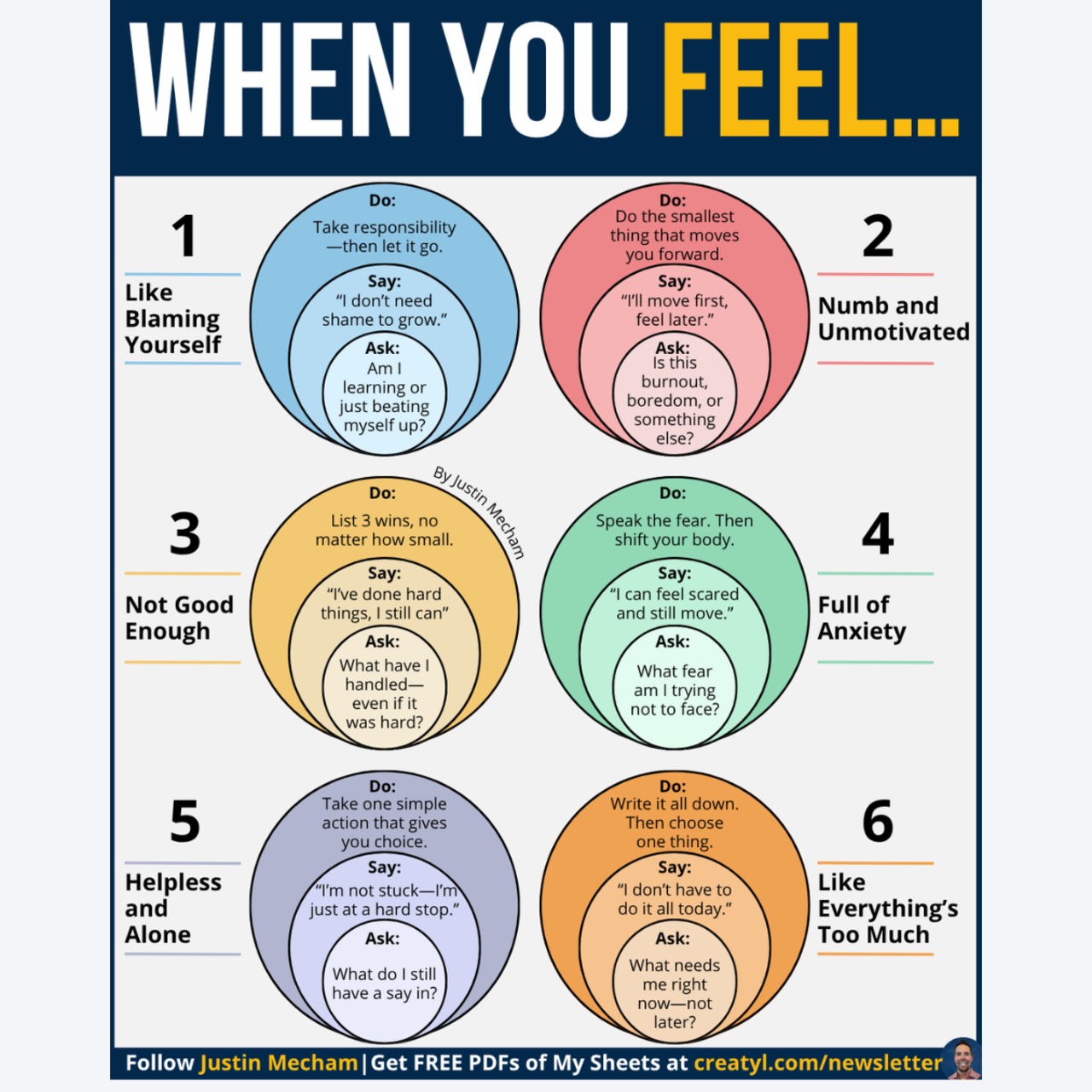Click Here To Download Today´s Infographic
How to Read Your Feelings, Reclaim Control, and Stop Spiraling at Work and in Life
We’ve all had days where it feels like our mind is working against us.
Maybe it starts with anxiety creeping in during your commute.
Or maybe it’s shame about missing a deadline, or feeling like no matter what you do—it’s never enough.
Some days you feel numb. Other days it all feels like too much.
But the truth is this:
Your feelings aren’t disqualifying you.
They’re trying to guide you.
Most people were never taught how to read their own signals.
So we do what we were taught instead:
- We spiral
- We shut down
- We blame ourselves
And then we wonder why nothing changes.
But the fix isn’t fixing everything.
It’s shifting one thing:
- One better question
- One clearer thought
- One small, doable action
This guide will show you how to do exactly that—with real-world workplace examples, actionable language, and proven tools.
Why Your Feelings Aren’t the Problem
Most high-achievers believe that emotions are distractions. That if you just “push through,” the overwhelm will go away.
But avoidance doesn’t solve emotional signals—it just delays them.
Here’s a better way to think about your feelings:
- Anxiety isn’t a flaw. It’s your brain trying to protect you from uncertainty.
- Shame isn’t proof you’ve failed. It’s a signal you’re out of alignment with your values.
- Overwhelm isn’t weakness. It means you care about too many things and haven’t clarified what matters most.
- Numbness isn’t laziness. It’s a red flag that your internal system is overstimulated, disconnected, or exhausted.
The goal isn’t to erase your emotions.
It’s to learn how to interpret them.
Let’s break this down—one feeling at a time.
When You’re Blaming Yourself
Say: “I don’t need shame to grow.”
Ask: “Am I learning, or just punishing myself?”
Do: Take responsibility—then let it go.
Real-Life Example: The Post-Review Spiral
After receiving a great performance review with just one piece of feedback—“You talk too much during presentations”—a team member spiraled.
They replayed every call, shrunk back in meetings, and began second-guessing their presence.
They weren’t processing. They were punishing.
When they wrote the feedback on paper and asked, “What can I do differently?” they stopped seeing it as shame and started seeing it as skill development.
They practiced shorter intros, rehearsed with a peer, and shared their plan with their lead.
The shift wasn’t dramatic—but it was powerful. They stopped spiraling. They started improving.
When You Feel Numb or Unmotivated
Say: “I’ll move first, feel later.”
Ask: “Is this burnout, boredom, or something else?”
Do: Do the smallest thing that moves you forward.
Real-Life Example: Quiet Quitting Misread
A teammate who once led creative meetings stopped contributing entirely. Deadlines slipped. They said, “I just don’t care anymore.”
Leaders started writing them off—until someone asked, “Is this burnout or boredom?”
That moment revealed everything. The teammate wasn’t checked out—they felt invisible.
They’d been delivering work, but no one noticed.
With one small change—giving them clear ownership and weekly check-ins—they started showing up again.
They didn’t “snap out of it.”
They took one step, then another.
That was enough.
When You Feel Not Good Enough
Say: “I’ve done hard things. I still can.”
Ask: “What have I handled—even if it was hard?”
Do: List three wins—no matter how small.
Real-Life Example: New Leader, No Confidence
Promoted into a new leadership role, one team member began avoiding decisions.
They deferred to others, agreed with everyone, and stayed silent in strategy calls.
Underneath it all? Fear of being seen as a fraud.
In a peer session, they wrote down three hard things they’d led before. Each one reminded them they weren’t “lucky”—they were capable.
That mental reset changed everything.
They began suggesting ideas, not asking for permission.
And their team followed their lead.
When You’re Full of Anxiety
Say: “I can feel scared and still move.”
Ask: “What fear am I trying not to face?”
Do: Speak the fear. Then shift your body.
Real-Life Example: The Pitch That Almost Didn’t Happen
On the night before a client pitch, one leader almost backed out. Despite weeks of prep, anxiety took over.
They worried about stumbling, being judged, blowing the opportunity.
Then they named the fear: “I’m scared I’ll look like a fraud.”
They stood up, shook out their hands, and shifted their posture.
The next morning, they opened the pitch with honesty—not perfection. And the client signed on.
They didn’t crush the fear. They moved with it.
When You Feel Helpless and Alone
Say: “I’m not stuck—I’m just at a hard stop.”
Ask: “What do I still have a say in?”
Do: Take one action that gives you choice.
Real-Life Example: Disconnected and Remote
A remote teammate stopped joining calls and gave short replies when messaged. Eventually, they stopped replying altogether.
No one knew what was happening.
In a check-in, they shared: “I feel like no one notices me. I feel erased.”
They were asked: “What do you still have a say in?” They replied, “I guess... I can choose to speak up.”
They sent one message. One brave, clear message:
“I feel disconnected. I’d like to talk more often.”
The next day, they were back in the loop.
They weren’t helpless. They just needed a way to reconnect.
When Everything Feels Too Much
Say: “I don’t have to do it all today.”
Ask: “What needs me now—not later?”
Do: Write everything down. Then choose one thing.
Real-Life Example: The Founder's Overload
In the middle of a launch week, a founder hit a wall.
Everything needed fixing.
Everything felt urgent.
Their child was sick. A team member quit. And Slack wouldn’t stop pinging.
They said: “I can’t do this.”
A mentor asked, “What’s the one thing that needs you now?”
They wrote it all down. Circled just one thing: finalize the pricing page.
That one decision slowed the chaos and reset their clarity.
Every day after, they did just one thing.
The launch happened. Not because they did everything—
But because they did what mattered most, one step at a time.
Let’s Go Deeper: Recommended Tools and Resources
These tools are not just useful—they’re action-ready and highly relevant for anyone navigating complex emotions in real time:
App: How We Feel (by Ben Silbermann and the How We Feel Project)
A free, science-backed emotion-tracking app developed with leading psychologists. Helps users label and better understand their emotions to make clearer decisions and reduce overwhelm. Built with privacy in mind and used by thousands worldwide.
Podcast: The Next Right Thing by Emily P. Freeman
A podcast designed for people who struggle with decision fatigue, inner pressure, or emotional overwhelm. Each episode offers a small, thoughtful practice to help listeners take one clear step forward. It’s honest, grounded, and especially useful in high-stress seasons.
Book: Daring Greatly by Brené Brown
A powerful read for anyone navigating self-doubt, emotional exhaustion, or the fear of not being enough. This book explores how vulnerability—when used with intention—can transform how we lead, connect, and show up in difficult moments. Brené Brown weaves research with deeply human storytelling to help readers let go of perfectionism, move through shame, and replace fear with courage. It’s especially useful for leaders, creatives, and anyone who wants to stop performing and start living with more clarity, truth, and inner steadiness.
The Shift That Changes Everything
Most of us were never taught that emotions are usable data.
We were taught to ignore them. To power through. To quiet down when things felt too heavy.
So when anxiety, shame, or overwhelm show up, we assume we’ve failed—or that we’re just “too much.”
But what if that noise in your head isn’t noise at all?
What if it’s your mind saying,
“Something matters here.”
“Something needs your care.”
You don’t need to win every internal battle.
You don’t need to erase what you feel.
You just need to read what it’s trying to tell you—and respond with clarity, not criticism.
The goal isn’t to become unshakable.
It’s to become someone who knows how to move even when shaken.
And sometimes, that starts with one question.
One sentence.
One step.
That’s enough.
Want the Visual Summary?
If you’d like to keep this message close or share it with your team, you can download a simple PDF version of the infographic featured in this article.
It’s perfect to print, pin up, or keep on your desktop for when things feel too heavy to sort through.




